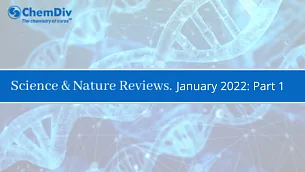Science & Nature Reviews, January 2021. Part II

ChemDiv shares reviews on Nature and Science Journal articles that we found the most exciting this month. Today we observe Molecular biology, COVID-19, Physiology, Genetic Engineering, Proteomics.
Molecular biology
Garcia-Martin, R., Wang, G., Brandão, B.B. et al. MicroRNA sequence codes for small extracellular vesicle release and cellular retention. Nature 601, 446–451 (2021)
A microRNA is a small single-stranded non-coding RNA molecule that functions in RNA silencing and post-transcriptional regulation of gene expression. These molecules could be a new promising therapeutic agent due to their ability to "turn off" a particular gene. MicroRNAs are released from cells into the circulation in small lipid vesicles called microvesicles. They provide a unique mode of cell-to-cell communication in which microRNAs are taken up by cells at a distance where they can execute their biological function. On the pages of Nature scientists demonstrate the mechanism by which miRNAs are sorted into microvesicles or retained in cells. This mechanism provides an approach for improved targeting in RNA-mediated therapies.
COVID-19
Cameroni, E., Bowen, J.E., Rosen, L.E. et al. Broadly neutralizing antibodies overcome SARS-CoV-2 Omicron antigenic shift. Nature (2021)
The Omicron variant of SARS-CoV-2 was only recently detected, but its subsequent spread has been extensive. Omicron contains 15 mutations on the receptor-binding domain, thereby raising concerns about the effectiveness of available vaccines and antibody therapeutics. Scientists detected that most monoclonal antibodies lost in vitro neutralizing activity against Omicron, with only 3 out of 29 monoclonal antibodies retaining unaltered potency. They also found the new variant to be markedly resistant to neutralization by serum from convalescent patients and from vaccinated individuals. However, broadly neutralizing antibodies recognizing sequences conserved among SARS-CoV-2 variants may prove key to controlling the ongoing pandemic.
Physiology
Silva, L. M., Doyle, A. D., Greenwell-Wild, T. et al. Fibrin is a critical regulator of neutrophil effector function at the oral mucosal barrier. Science 374, 6575 (2021)
Periodontitis, inflammation of the oral mucosa, afflicts about half a billion individuals worldwide. This disease has been associated with local deposition of fibrin. Plasmin is an important enzyme present in blood that degrades many blood plasma proteins, including fibrin clots. Researchers report that, like humans, mice lacking plasminogen accumulate fibrin and develop periodontitis. This mechanism may be an attractive target for future treatments of this prevalent disease.
Genetic Engineering
Zhou, Q., Chin, M., Fu, Y. et al. Stereodivergent atom-transfer radical cyclization by engineered cytochromes P450. Science 374, 6575, 1612-1616 (2021)
Chemical reactions can at times be executed with natural enzymes, reengineered enzymes, or even “artificial” enzymes. However, activity of naturally occurring enzymes can create an unnatural effect. This activity can be molded by directed evolution that accumulates constructive mutations to generate efficient biocatalysts with valuable activities. So, in their new research scientists have been able to teach natural enzymes new radical tricks. A series of enzyme variants called metalloproteins were generated by directed evolution to catalyze reactions distinct from their natural function. Such biocatalysts are valuable additions to the synthetic chemistry toolkit and can be used in pharmaceuticals.
Proteomics
Brinkerhoff, H., Kang , A. S. W., Liu, J. et al. Multiple rereads of single proteins at single–amino acid resolution using nanopores. Science 374, 6574, 1509-1513 (2021)
DNA sequencing is the process of determining the nucleic acid sequence – the order of nucleotides in DNA. Proteins are important for the proper function of living systems, and so proteomics methods that provide the sequence of proteins in a single cell is a key goal. Nanopore technology enables sensing of minute chemical changes at the single-molecule level as molecules are drawn through a membrane-embedded pore. This method is commonly used for DNA sequencing. On pages of Science researchers demonstrate a nanopore-based approach in which a protein was sequentially scanned in single-amino-acid steps through the narrow construction of a nanopore. So, new proteomics tools capable of identifying single proteins would be important for cell biology research and applications.
Molecular biology
Garcia-Martin, R., Wang, G., Brandão, B.B. et al. MicroRNA sequence codes for small extracellular vesicle release and cellular retention. Nature 601, 446–451 (2021)
A microRNA is a small single-stranded non-coding RNA molecule that functions in RNA silencing and post-transcriptional regulation of gene expression. These molecules could be a new promising therapeutic agent due to their ability to "turn off" a particular gene. MicroRNAs are released from cells into the circulation in small lipid vesicles called microvesicles. They provide a unique mode of cell-to-cell communication in which microRNAs are taken up by cells at a distance where they can execute their biological function. On the pages of Nature scientists demonstrate the mechanism by which miRNAs are sorted into microvesicles or retained in cells. This mechanism provides an approach for improved targeting in RNA-mediated therapies.
COVID-19
Cameroni, E., Bowen, J.E., Rosen, L.E. et al. Broadly neutralizing antibodies overcome SARS-CoV-2 Omicron antigenic shift. Nature (2021)
The Omicron variant of SARS-CoV-2 was only recently detected, but its subsequent spread has been extensive. Omicron contains 15 mutations on the receptor-binding domain, thereby raising concerns about the effectiveness of available vaccines and antibody therapeutics. Scientists detected that most monoclonal antibodies lost in vitro neutralizing activity against Omicron, with only 3 out of 29 monoclonal antibodies retaining unaltered potency. They also found the new variant to be markedly resistant to neutralization by serum from convalescent patients and from vaccinated individuals. However, broadly neutralizing antibodies recognizing sequences conserved among SARS-CoV-2 variants may prove key to controlling the ongoing pandemic.
Physiology
Silva, L. M., Doyle, A. D., Greenwell-Wild, T. et al. Fibrin is a critical regulator of neutrophil effector function at the oral mucosal barrier. Science 374, 6575 (2021)
Periodontitis, inflammation of the oral mucosa, afflicts about half a billion individuals worldwide. This disease has been associated with local deposition of fibrin. Plasmin is an important enzyme present in blood that degrades many blood plasma proteins, including fibrin clots. Researchers report that, like humans, mice lacking plasminogen accumulate fibrin and develop periodontitis. This mechanism may be an attractive target for future treatments of this prevalent disease.
Genetic Engineering
Zhou, Q., Chin, M., Fu, Y. et al. Stereodivergent atom-transfer radical cyclization by engineered cytochromes P450. Science 374, 6575, 1612-1616 (2021)
Chemical reactions can at times be executed with natural enzymes, reengineered enzymes, or even “artificial” enzymes. However, activity of naturally occurring enzymes can create an unnatural effect. This activity can be molded by directed evolution that accumulates constructive mutations to generate efficient biocatalysts with valuable activities. So, in their new research scientists have been able to teach natural enzymes new radical tricks. A series of enzyme variants called metalloproteins were generated by directed evolution to catalyze reactions distinct from their natural function. Such biocatalysts are valuable additions to the synthetic chemistry toolkit and can be used in pharmaceuticals.
Proteomics
Brinkerhoff, H., Kang , A. S. W., Liu, J. et al. Multiple rereads of single proteins at single–amino acid resolution using nanopores. Science 374, 6574, 1509-1513 (2021)
DNA sequencing is the process of determining the nucleic acid sequence – the order of nucleotides in DNA. Proteins are important for the proper function of living systems, and so proteomics methods that provide the sequence of proteins in a single cell is a key goal. Nanopore technology enables sensing of minute chemical changes at the single-molecule level as molecules are drawn through a membrane-embedded pore. This method is commonly used for DNA sequencing. On pages of Science researchers demonstrate a nanopore-based approach in which a protein was sequentially scanned in single-amino-acid steps through the narrow construction of a nanopore. So, new proteomics tools capable of identifying single proteins would be important for cell biology research and applications.



